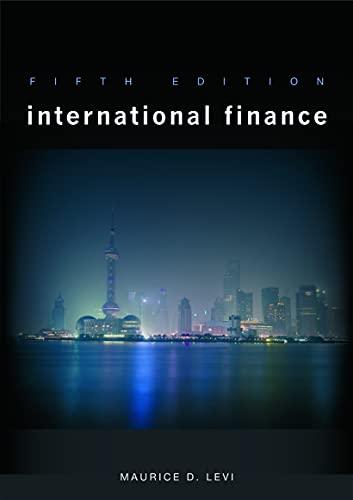2. A US automobile manufacturer, National Motors, is considering building a new plant in Britain to produce
Question:
2. A US automobile manufacturer, National Motors, is considering building a new plant in Britain to produce its sports car, the Sting.The estimated construction cost of the plant is £50,000,000, and construction should be completed in a year.The plant will raise borrowing capacity by about $40,000,000. National Motors can reinvest £20,000,000 already held in Britain. If these funds were repatriated to the United States, they would face an effective tax rate of 46 percent. Inflation in Britain is expected to be at 15 percent; in the United States, at 10 percent.The current exchange rate is S($/£) = 2.00, and it is believed that PPP will hold on average over the relevant time frame.
National Motors expects to sell the Sting with only minor modifications for five years, and after this period the plant will require remodeling.The value of the plant for future use is expected to be £40,000,000 in nominal terms after five years.The Sting will have an initial sticker price of about £8,000, and it is expected that 10,000 will be sold each year.Production costs are estimated at £6,000.These values are expected to move in line with the general price level in Britain.
National Motors also builds a two-seater car in Germany called the Racer and expects 4,000 Racers to be replaced by the Sting. Since Racers are in short supply, 2,000 of the 4,000 Racers can be sold in Japan at the same profit as in Germany.The expected before-tax profit on the Racer during the initial year of producing the Sting is e2,500 per car, with S(e/£) = 2.00.This is expected to keep in line with German inflation, and PPP is expected to prevail over the relevant time frame between Britain and Germany.
Because National Motors will be building the Sting in Merseyside, an area of heavy unemployment, the British government has offered the company a loan of £20,000,000 at a 10 percent interest rate.The principal is to be repaid in five equal annual installments, with the first installment due at the beginning of the initial year of production.The competitive market rate in Britain is 20 percent, while in the United States National Motors faces a borrowing rate of 12 percent and the riskless rate is 10 percent.The balance of the capital will be provided as equity.The tax rate in Britain is 50 percent, which is higher than the 46 percent rate in the United States.
British tax law allows car plants to be depreciated over five years.
The British and US tax authorities are careful that appropriate transfer prices are used so that no taxes can by saved by using inter-company pricing techniques. National Motors believes a 20 percent discount rate is appropriate for the project.
Should the Sting be built?
Step by Step Answer:







